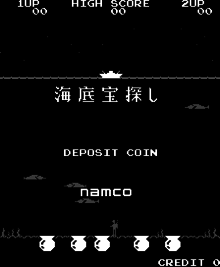Kaitei Takara Sagashi
Kaitei Takara Sagashi (海底宝探し, Kaitei Takara Sagashi) is a 1980 arcade game, which was originally developed by K. K. Tokki as the prototype that later sold it to Namco, where it was completely rewritten; it also became the second of the three monochromatic games they released during the early part of that year (the first was Navarone and the third was SOS). The title of the game also translates into English as "Undersea (or "Underwater") Treasure Hunting" or “Sea Hunt”.
| Kaitei Takara Sagashi | |
|---|---|
 Title screen | |
| Developer(s) | K. K. Tokki |
| Publisher(s) | Namco |
| Designer(s) | Shigeichi Ishimura[1] |
| Programmer(s) | Shuichi Nakatome[1] |
| Platform(s) | Arcade |
| Release | |
| Genre(s) | Action |
| Mode(s) | Up to 2 players, alternating turns |
| Cabinet | Upright, cabaret, and cocktail |
| Arcade system | Namco Warp & Warp |
| CPU | 1 x Intel 8080 @ 2.048 MHz |
| Sound | 1 x custom WSG @ 2.048 MHz |
| Display | Vertical orientation, Raster, 224 x 272 resolution |
Gameplay

Use the 2-way joystick to direct the boat across the surface of the ocean, then press the button to lower the diver down to the bottom of the ocean while watching out for the sharks swimming across the screen. During this time, you can hold the button to pause the diver's descent and push the joystick in either direction to fire a harpoon at the sharks for 30-300 points apiece. Once the diver has reached the bottom of the ocean, push the joystick in either direction to make him walk towards either of the two treasure caches that are closest to him (the boat will automatically follow his movements at this point). When the diver is directly over a treasure cache, the boat will lower him into it. The number of points you will receive when you make it back onto the surface of the ocean, which can range from 50-250, will then appear on the screen, and the boat will raise the diver back up to the surface of the ocean. Once again, you can hold the button to pause the diver's ascent, and push the joystick in either direction to fire a harpoon at the sharks. Once you have made it back up to the surface of the ocean, you will have to repeat the entire process for each of the four remaining treasure caches before the game proceeds to the next round.
References
- Szczepaniak, John (11 August 2014). The Untold History of Japanese Game Developers (First ed.). p. 201. ISBN 978-0992926007. Retrieved 12 August 2019.
- "Release date". Retrieved 2013-06-15.